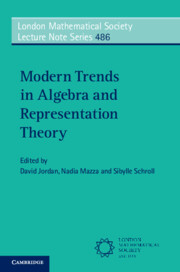Book contents
- Frontmatter
- Contents
- Contributors
- Preface
- Introduction
- 1 Auslander–Reiten Theory of Finite-Dimensional Algebras
- 2 τ-tilting Theory – an Introduction
- 3 From Frieze Patterns to Cluster Categories
- 4 Infinite-dimensional Representations of Algebras
- 5 The Springer Correspondence
- 6 An Introduction to Diagrammatic Soergel Bimodules
- 7 A Companion to Quantum Groups
- 8 Infinite-dimensional Lie Algebras and Their Multivariable Generalizations
- 9 An Introduction to Crowns in Finite Groups
- 10 An Introduction to Totally Disconnected Locally Compact Groups and Their Finiteness Conditions
- 11 Locally Analytic Representations of p-adic Groups
- References
7 - A Companion to Quantum Groups
Published online by Cambridge University Press: 25 November 2023
- Frontmatter
- Contents
- Contributors
- Preface
- Introduction
- 1 Auslander–Reiten Theory of Finite-Dimensional Algebras
- 2 τ-tilting Theory – an Introduction
- 3 From Frieze Patterns to Cluster Categories
- 4 Infinite-dimensional Representations of Algebras
- 5 The Springer Correspondence
- 6 An Introduction to Diagrammatic Soergel Bimodules
- 7 A Companion to Quantum Groups
- 8 Infinite-dimensional Lie Algebras and Their Multivariable Generalizations
- 9 An Introduction to Crowns in Finite Groups
- 10 An Introduction to Totally Disconnected Locally Compact Groups and Their Finiteness Conditions
- 11 Locally Analytic Representations of p-adic Groups
- References
Summary
In this chapter we give an introductory account of quantum groups (and more generally, quasitriangular bialgebras), allowing the reader to familiarize themselves with the basic concepts and constructions in this modern area of study in algebra and representation theory. This material accompanies online graduate lectures on quantum groups given by the author at the London Mathematical Society Autumn Algebra School in 2020. We also provide some supplementary material, mainly in the last section on cylindrical quasitriangularity.
- Type
- Chapter
- Information
- Modern Trends in Algebra and Representation Theory , pp. 227 - 272Publisher: Cambridge University PressPrint publication year: 2023

